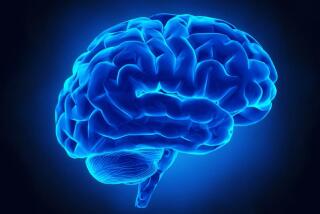Op-Ed: A secret epidemic: Traumatic brain injury among domestic violence victims
In recent years, medical science has uncovered the high risk and devastating effects of traumatic brain injury, or TBI, among U.S. combat soldiers and athletes, especially football and hockey players. What if a vastly greater population were also suffering these effects: women and children living with the consequences of domestic violence?
For as long as I can remember, my mother took aspirin every day, complaining of unbearable headaches. Sometimes she locked herself in the bedroom with the lights off, asking me to take my siblings outside because she couldn’t tolerate the noise. As she got older, her naps grew longer and her sensitivity to light and noise intensified. By her 50s, her memory had begun to fail.
On the day she finally asked me to take her away from my father, I found her in a worse state than I had ever seen her. She could barely stand. She was crawling from room to room while my father ignored her.
Her doctors asked the same question again and again: “What type of head trauma has your mother had?” I always answered the same way: “Over 40 years of severe, ongoing trauma.” They focused on treating her physical symptoms. They ignored her history of violent abuse by my father.
My mother never played a violent sport or fought in a war. But the assaults she endured on her head and body were at least as acute as those experienced by athletes and soldiers, and the effects were the same. When all the tests were finished, the neurologist told us my mother was suffering from moderate to severe Alzheimer’s disease. The head trauma had been so great and so consistent that there was little they could do.
My mother died in June from the debilitating effects of her abuse. She was receiving hospice care — bedridden, unable to speak or recognize her children.
There are few empirical studies on the prevalence of TBI among women and children affected by domestic violence. But evidence so far strongly indicates a silent epidemic, with major public health ramifications.
A 2001 study found that 67% of women seeking emergency medical support for injuries stemming from domestic violence had symptoms related to TBI, and 30% reported loss of consciousness.
A 2002 survey of three domestic violence shelters found that 92% of the women had been hit on the head by their partners. Applying that figure nationally, the size of the potentially affected population would be astonishingly high: about 20 million women exposed to the risk of TBI each year, and, given the documented association between partner abuse and child abuse, millions more children.
Domestic violence shelters do not generally screen clients for TBI, and staff members are not trained to address it if encountered. As a result, they can inadvertently make matters worse for those who have sustained TBI by requiring participants to join in physically demanding program activities immediately after they arrive.
There is ample anecdotal evidence of the connection between domestic violence and TBI in stories like my mother’s, but we must dig deeper. We must accumulate data, develop screening protocols and appropriate treatment programs, and spread awareness to our nation’s shelters and domestic violence facilities. We must treat domestic violence like the emergency that it is, one that impairs the ability of those affected to fully participate in the workforce, in education and in their communities.
Today, I grieve my mother’s passing, too soon and far from peaceful. But I am inspired by the thought that with a full reckoning of the relationship between traumatic brain injury and domestic violence, another family may avoid such a fate.
Maria E. Garay-Serratos is chief executive of Sojourner Center, a domestic violence shelter in Phoenix. In June, the center launched the BRAIN Program for research and treatment of traumatic brain injury in women and children living with domestic violence.
Follow the Opinion section on Twitter @latimesopinion and Facebook
More to Read
A cure for the common opinion
Get thought-provoking perspectives with our weekly newsletter.
You may occasionally receive promotional content from the Los Angeles Times.






